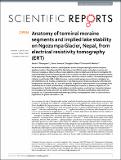Files in this item
Anatomy of terminal moraine segments and implied lake stability on Ngozumpa Glacier, Nepal, from electrical resistivity tomography (ERT)
Item metadata
| dc.contributor.author | Thompson, Sarah S. | |
| dc.contributor.author | Kulessa, Bernd | |
| dc.contributor.author | Benn, Douglas I. | |
| dc.contributor.author | Mertes, Jordan R. | |
| dc.date.accessioned | 2018-01-04T16:30:09Z | |
| dc.date.available | 2018-01-04T16:30:09Z | |
| dc.date.issued | 2017-04-20 | |
| dc.identifier | 251876713 | |
| dc.identifier | 14c864ac-c758-4a37-9ad6-54b1609e811f | |
| dc.identifier | 85038836924 | |
| dc.identifier | 000425902800001 | |
| dc.identifier.citation | Thompson , S S , Kulessa , B , Benn , D I & Mertes , J R 2017 , ' Anatomy of terminal moraine segments and implied lake stability on Ngozumpa Glacier, Nepal, from electrical resistivity tomography (ERT) ' , Scientific Reports , vol. 7 , 46766 . https://doi.org/10.1038/srep46766 | en |
| dc.identifier.issn | 2045-2322 | |
| dc.identifier.other | ORCID: /0000-0002-3604-0886/work/64697400 | |
| dc.identifier.uri | https://hdl.handle.net/10023/12433 | |
| dc.description | This research was supported financially by the European Commission FP7-MC-IEF (PIEF-GA-2012-330805), the University Centre in Svalbard (UNIS), National Geographic Society GRANT #W135-10. | en |
| dc.description.abstract | Moraine-dammed lakes at debris-covered glaciers are becoming increasingly common and pose significant outburst flood hazards if the dam is breached. While moraine subsurface structure and internal processes are likely to influence dam stability, only few sites have so far been investigated. We conducted electrical resistivity tomography (ERT) surveys at two sites on the terminal moraine complex of the Ngozumpa Glacier, Nepal, to aid assessment of future terminus stability. The resistivity signature of glacier ice at the site (100-15 kΩ m) is more consistent with values measured from cold glacier ice and while this may be feasible, uncertainties in the data inversion introduce ambiguity to this thermal interpretation. However, the ERT data does provide a significant improvement to our knowledge of the subsurface characteristics at these sites, clearly showing the presence (or absence) of glacier ice. Our interpretation is that of a highly complex latero-terminal moraine, resulting from interaction between previous glacier advance, recession and outburst flooding. If the base-level Spillway Lake continues to expand to a fully formed moraine-dammed glacial lake, the degradation of the ice core could have implications for glacial lake outburst risk. | |
| dc.format.extent | 12 | |
| dc.format.extent | 1477481 | |
| dc.language.iso | eng | |
| dc.relation.ispartof | Scientific Reports | en |
| dc.subject | GE Environmental Sciences | en |
| dc.subject | QE Geology | en |
| dc.subject | NDAS | en |
| dc.subject.lcc | GE | en |
| dc.subject.lcc | QE | en |
| dc.title | Anatomy of terminal moraine segments and implied lake stability on Ngozumpa Glacier, Nepal, from electrical resistivity tomography (ERT) | en |
| dc.type | Journal article | en |
| dc.contributor.institution | University of St Andrews. School of Geography & Sustainable Development | en |
| dc.contributor.institution | University of St Andrews. Bell-Edwards Geographic Data Institute | en |
| dc.identifier.doi | https://doi.org/10.1038/srep46766 | |
| dc.description.status | Peer reviewed | en |
This item appears in the following Collection(s)
Items in the St Andrews Research Repository are protected by copyright, with all rights reserved, unless otherwise indicated.

